Global ATR Protein Inhibitors Clinical Trials & Market Opportunity Insight 2024 Report Highlights:
- ATR Protein Inhibitors In Clinical Trials: > 15 Drugs
- China Dominates ATR Protein Inhibitors Clinical Trials: > 60% Trials
- Highest Clinical Phase: Phase-III
- Global ATR Protein Inhibitors Clinical Pipeline By Company, Indication & Phase
- ATR Inhibitors Development Trends by Country
- Competitive Landscape
Inhibition of the Ataxia telangiectasia and Rad3 related kinase, or ATR kinase, has emerged as a promising avenue in the ever evolving landscape of cancer pharmaceutical research. ATR is a serine/threonine-protein kinase that acts as a guardian of genomic integrity by playing a critical role in the cellular response to DNA damage. Dysregulation of ATR has been linked to various diseases, particularly cancer, and inhibiting ATR presents a novel opportunity to exploit the vulnerabilities of cancer cells and enhance the efficacy of existing therapies. No ATR inhibitors have received regulatory approval as of yet; however, with several investigational candidates in the development pipeline now entering phase II trials, these novel inhibitors are anticipated to gain more attention in the years to come.
The primary focus of ATR inhibition is in the realm of oncology. ATR inhibitors have shown promise in enhancing the effectiveness of DNA-damaging cancer therapies such as chemotherapy and radiation, making hem potential candidates for combination therapies in various cancer types such as ovarian cancer, bile duct carcinoma, breast carcinoma, small cell cancer and high grade neuroendocrine cancers among other advanced solid tumors, as well as some hematological malignancies. Some ATR-inhibiting candidates being investigated in these cancers are ATG-018, Elimusertib (BAY 1895344), Camonsertib (RP-3500), and Ceralasertib (AZD6738), which have been developed by Antengene, Bayer, Repare Therapeutics, and AstraZeneca, respectively. These candidates are now in various phases of clinical evaluation.
Recent research, however, has expanded the scope of ATR inhibitors to neurodegenerative diseases. ATR kinase has implications in maintaining neuronal genomic activity, making it a potential target for conditions like Parkinson's disease and Alzheimer's disease. Further studies are linking ATR with microbial infections, especially those caused by viruses. Along with ATM, or Ataxia-telangiectasia mutated kinase, ATR is exploited by viruses to facilitate viral replication and increase expression of viral proteins. In the case of HIV-1 and COVID-19, both of which have high infection and mortality rates, ATR inhibition has represented another promising prospect for the development of novel therapeutics to manage these diseases.
As a result, the pharmaceutical industry has invested significantly in the development of ATR inhibition, and several clinical trials are being conducted now to evaluate the efficacy of these candidates. VE-821, developed by Vertex Pharmaceuticals, was the first specific ATR inhibitor to be developed, which served as the blueprint for the development of VE-822, now licensed to Merck as Berzosertib. The drug further served as the foundation for M1774, a potent ATR inhibitor being studied by Merck in various solid cancers. Both Berzosertib and M1774 have demonstrated encouraging results in early phase clinical trials in combination with chemotherapy. Administration of these ATR inhibitors enhanced the sensitivity of cancer cells to DNA-damaging chemotherapies, which makes the elimination of cancer cells faster.
ATR inhibitors pose several benefits over other cancer therapies. As described above, ATR inhibitors sensitize cancer cells to conventional therapies, potentially reducing the required dosage and mitigating side effects. Conventional therapies are potent but also face several limitations, majorly resistance to treatment. ATR inhibition can help overcome resistance mechanisms that cancer cells development against treatment, therefore improving patient outcomes. Further, ATR inhibitors can also enable a more personalized approach to cancer treatment by targeting specific genetic vulnerabilities in patients. In the realm of neurodegenerative diseases and viral infections, ATR inhibition holds the promise of slowing or preventing disease progression and improving the quality of life of affected individuals.
Despite the optimism surrounding ATR inhibitors as outlined by their advantages over existing therapies, challenges exist such as the need for refined patient section criteria and a deeper understanding of the potential side effects. However, their future potential is vast. As ATR inhibitors continue to show promise, their integration into combination therapies is expected to become more common, potentially reshaping cancer treatment regimens. Moreover, advances in molecular profiling and genetic testing may enable a more targeted ATR inhibition.
The ongoing clinical and market trends for ATR inhibitors present a compelling narrative in the pharmaceutical domain. The novel approach to targeting DNA damage response pathways holds the promise of revolutionizing cancer treatment, as well as entering the treatment protocols for neurodegenerative and infectious diseases. With ongoing research studies revealing more about ATR kinase and its implications in different indications, it is understood the full potential of ATR inhibition is yet to be realized. As this happens, a new wave of development in the global pharmaceutical market is anticipated, which makes the ATR inhibition an exciting field.
Table of Contents
Companies Mentioned (Partial List)
A selection of companies mentioned in this report includes, but is not limited to:
- Antengene Corporation
- Aprea
- AstraZeneca
- Bayer
- Beijing Tide Pharmaceutical
- Biocity Biopharmaceutics
- Chipscreen Biosciences
- IMPACT Therapeutics
- Laevoroc Neuro-Oncology
- Repare Therapeutics
- Shanghai De Novo Pharmatech
- Shanghai Junshi Biosciences
- ShangPharma
- Vertex Pharmaceuticals








